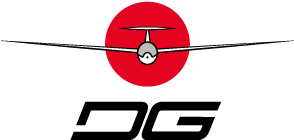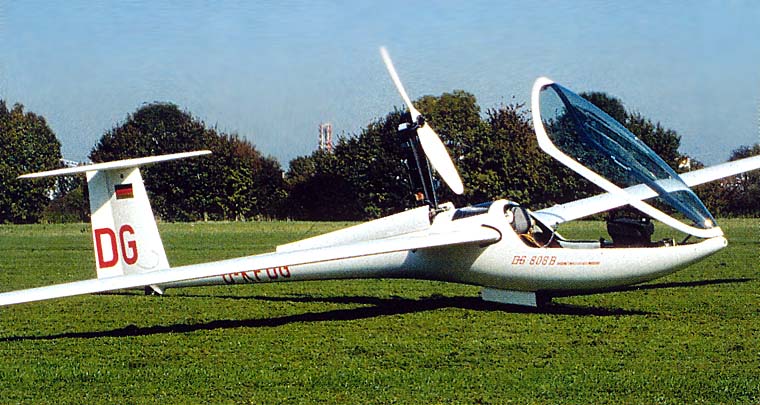A report by Gerhard Marzinzik, published in the German Aerokurier
It has become increasingly difficult to improve a glider’s performance while maintaining a given wingspan.
Some room for further development is possible in the handling of a glider.
And this has now been applied to the DG-800B.
Since 1996 the focus of production at DG-Flugzeugbau in Bruchsal has been the DG-800B, a self-launching motor glider with a wingspan of 18 m. With the predecessor introduced as early as 1994, this version of the 800 model with the 54 HP SOLO 2625 engine has already sold more than 300 units. Now it has been updated and flies under the name DG-808B.
The changes that have been made to this successful model are not immediately apparent, but need to be pointed out. They do however vastly improve the glider’s handling on the ground and in flight.
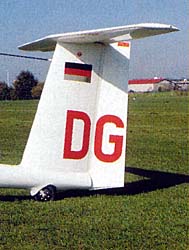 By moderately modifying the glider’s tail section, chief designer Dipl. Ing. Wilhelm Dirks sought to achieve a better coordination of ailerons and rudder and therefore improved handling in thermals.
By moderately modifying the glider’s tail section, chief designer Dipl. Ing. Wilhelm Dirks sought to achieve a better coordination of ailerons and rudder and therefore improved handling in thermals.
The modification of the vertical stabilizer reflects a trend currently found in a lot of other manufacturers’ gliders: the stabilizer is now bigger; this improves the effectiveness of the rudder. At the same time thanks to the new bearing of the tail wheel the rudder can be moved more easily.
A straight yaw string without cheating
The improvements are immediately noticeable in flight. When flying the DG-800B one had to apply significantly more rudder that ailerons when starting to turn. Equally, once a turn had been established in the DG-800B one had to centralize the aileron before the rudder to ensure that the string didn’t veer off to one side.
Now, however, the DG-808B will do a nice coordinated turn if both controls are applied in equal amounts – and the rudder is a lot easier to move.
Increasing the length of the stabilizer by 3 cm – a minimal modification – has thus improved the glider’s flight characteristics enormously. The increased fuselage length shouldn’t impact the glider’s performance.
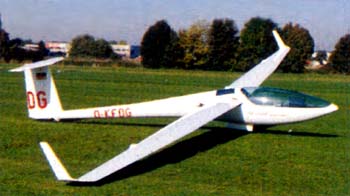 With the winglets on, the DG-808B flies like it’s on rails. On the sunny day in October, when I flew the 808, the stable weather conditions probably supported this impression, but even when I provoked instability the 808 remained docile. I could let go of the controls and it would still carry on in the same direction – both in a straight line and in a turn.
With the winglets on, the DG-808B flies like it’s on rails. On the sunny day in October, when I flew the 808, the stable weather conditions probably supported this impression, but even when I provoked instability the 808 remained docile. I could let go of the controls and it would still carry on in the same direction – both in a straight line and in a turn.
The roll rate has not suffered from the modifications. Changes of bank from 45° to 45° angles at 90 kph (49 kts) with a positive flap setting take less than 3 seconds.
I did not notice any negative effect of the winglets. For example, side slipping the DG-808B is possible both to the right and to the left. However, with a positive flap setting and the undercarriage lowered, the big two-bladed airbrakes provide a sink rate of up to 5 m/s – which means that side slipping as a further landing aid might never be necessary.
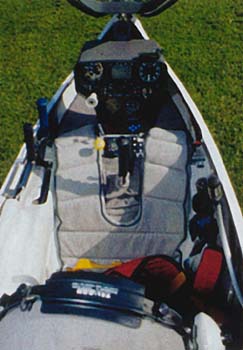
The electronic engine control (DEI) has become something of a classic feature. It makes using the engine incredibly simple. If you set the ignition switch to “On” (“Ein”), the propeller is moved out of the fuselage and activates the ignition when it’s reached its final position. You can then start the engine with the start button in the throttle control. Any necessary priming is done automatically.
Retracting the propeller is equally simple. When the engine is idling and the ignition is switched off the propeller will stop turning. If it does not stop in the vertical position it can be moved by pressing the start button. This will not activate the ignition. Once in the vertical position, the brake will stop the propeller from moving further. Retracting the propeller and closing the engine compartment cover are done automatically. Both operations take less than 20 seconds each.
The 54 HP SOLO engine provides more than enough power for the DG-808B. On the short airfield in Bruchsal (500 m grass runway) the motor glider takes off before it is halfway down the runway.
In the first stage of acceleration you don’t have to be careful not to open the throttle too much, as there is no tendency for the nose to drop even when you open the throttle fully. Even with a positive flap setting the ailerons are very effective, which improves the takeoff characteristics and means that you can use a positive flap setting right from the start – you don’t have to change the flap setting at any time.
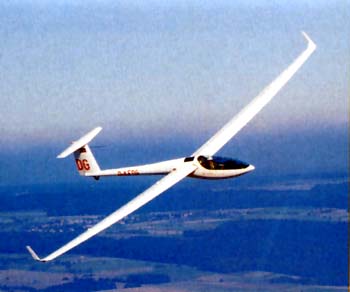
With a noise level of 61.8 dB(A) according to Kap. VI (57.1 dB(A) according to Kap. 10) the DG-808B meets the current, more stringent noise regulations and is therefore also well prepared for the future.
In soaring flight the engine weight does not cause any problems for the 808. Thanks to its large wing area the minimal wing load for weak weather conditions is 34.5 kg/m². This is a wing load similar to other un-motorized gliders. For this reason, the DG-800 has for some time had the reputation of being a good climber. The 808’s performance in the glide is also nothing to complain about.
DG-Flugzeugbau quotes the best glide angle at 110 kph (60 kts) as over 50:1.
Gerhard Marzinzik,
translation by Claudia Büngen
